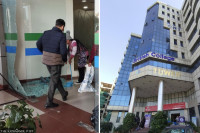National
Census leaves out the count of queer population with no data on them
There were issues with the questionnaire. Authorities failed to address them.
Prithvi Man Shrestha
The Central Bureau of Statistics (CBS) on January 26 announced that Nepal’s population reached 29,192,480, with 51.04 percent female and the rest male, without releasing any data collected under the ‘others’ category.
CBS categorised people of marginalised sexual orientation, gender identity, gender expression, and sex characteristics (SOGIESC) under the term ‘others.’
This categorisation itself faced criticism, as many queer activists argued that putting queer people under a common category is disrespecting the diversity of the queer spectrum.
In 2020, queer activist Rukshana Kapali along with a few other fellow activists had filed a writ petition against CBS’ decision of boxing queer people within a single category. There hasn’t been a court hearing though.
“There is no point in collecting LGBTQI+ data under "Others” gender category. That is by definition a blunder,” wrote queer activist Kapali on Facebook after CBS announced its preliminary findings a few days ago.
But the CBS’ preliminary report has unveiled the population as males and females. However, this categorization was limited to the House and Household Listing Survey, and left out in the main questionnaire.
In the census of 2011, only 1,500 individuals identified themselves under the ‘third gender’ category but the queer communities rejected this data saying that this has underrepresented their population.
Hem Raj Regmi, deputy director-general at the Bureau, stated that the total population figure has accommodated the population of gender and sexual minorities.
The Bureau, however, clarified that the data on queer population would be released in the final report of the census after seven to eight months.
The census was conducted in two phases.
During the first phase, the House and Household Listing survey was conducted from September 15 to October 4 last year. In the survey, they had collected information about people who identified their gender as ‘others’.
The second phase of the census – the main census – was conducted from November 11 to November 25. The main census, however, did not collect disaggregated data on gender; it only had the male and female categories.
“The preliminary data about the census was produced from the census based on main questionnaires,” said Regmi. “We have not conducted data processing of House and Household Listing survey that has data on queer individuals.”
After the data about the LGBTQI+ population was not released during the preliminary data dissemination on January 26, the representatives of the communities asked the bureau for justifications.
“We were told that no data processing has taken place yet about the census of LGBTQI+,” said Manisha Dhakal, executive director of Blue Diamond Society, a representative body of LGBTQI+ in the country.
Though the census of the queer population was conducted as part of the broader population census, officials and stakeholders are more or less sure that the census will underrepresent the true number of the queer population.
Enumerators have notified the officials at the bureau that there are not many who have identified themselves as ‘others’. “The representatives of the gender and sexual minorities say that they are in large number. But during the census, only a few people have come forward identifying themselves as sexual minorities” said Regmi.
“Mostly those who are living separately from their families in the urban areas have only come forward to identify themselves as sexual minorities.”
Not only are queer individuals hesitant to share their gender identity due to fear of stigmatization and ostracization by their family and society, but the enumerators also did not perform well on collecting gender-disaggregated data.
“Firstly, many queer individuals are hesitant to share their gender identities publicly because they are scared of the reaction they might face,” says Dhakal. “Secondly, enumerators didn’t do a good job in gathering that data.”
“Enumerators don’t ask about the presence of gender and sexual minorities in many locations and simply assumed a binary gender. Even at my home, they didn’t inquire about us,” Dhakal said.
Considering the stigma that gender and sexual minorities face in publicly identifying themselves as queer, representatives of Blue Diamond Society had trained and sensitized the key trainers of the bureau and census supervisors ahead of the census, in addition to awareness campaigns conducted for queer individuals.
Even though representatives of gender and sexual minorities are skeptical whether the census will provide accurate data on their population, they are, nevertheless, hopeful that the official data will assist them in their advocacy.
According to various studies, Dhakal said that around 8-10 percent of the total population should be queer. “Irrespective of the number, the government recognizing the fact there are gender and sexual minorities would help the queer people to demand representation in the state,” she said.
Although the constitution has talked about the rights of sexual minorities, it has excluded their political representation in a proportional manner. “We will lobby hard for our representation in the state agencies after the census results come out,” she said.




 8.12°C Kathmandu
8.12°C Kathmandu













%20(1).jpg&w=300&height=200)

